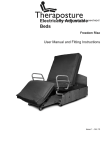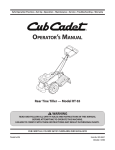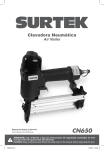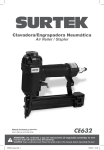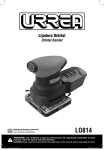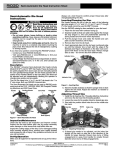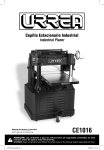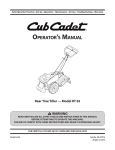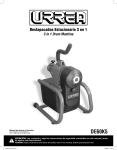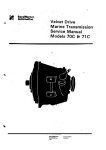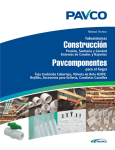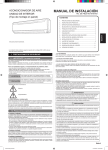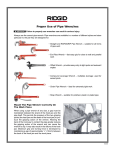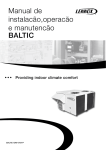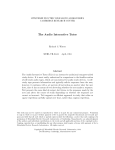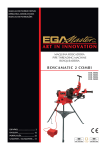Download TRM300 - Urrea
Transcript
Roscadora de Tubos Threading Machine Manual de Usuario y Garantía. User’s Manual and Warranty. TRM300 ATENCIÓN: Lea, entienda y siga las instrucciones de seguridad contenidas en este manual, antes de operar esta herramienta. WARNING: Read, understand and follow the safety rules in this manual, before operating this tool. TRM300 manual.indd 1 09/06/15 15:10 E S P A Ñ O L E N G L I S H CONTENIDO CONTENT Normas generales de seguridad 3 General safety rules 12 Características 6 Features 14 Instrucciones de operación 6 Operation instructions 15 Mantenimiento 9 Maintenance 17 Solucionador de problemas 11 Troubleshooting 18 Especificaciones técnicas 11 Technical data 19 Garantía 20 Warranty policy 20 2 TRM300 manual.indd 2 09/06/15 15:10 E S P A Ñ O L • NORMAS GENERALES DE SEGURIDAD • Asegúrese de observar las precauciones de Seguridad descritas más adelante para prevenir accidentes como incendios, choques eléctricos y lesiones. • Lea cuidadosamente estas Precauciones de Seguridad antes de utilizar la máquina, y manéjela de acuerdo con las instrucciones. • No utilice la máquina de ninguna otra forma que no sea la que se describe en este manual de operación. ADVERTENCIAS GENERALES 1. Asegúrese de estar utilizando el voltaje correcto indicado en la placa de características de la unidad principal o lo que se encuentra en el manual de operación. Si el voltaje es diferente al indicado, puede producirse sobrecalentamiento, humo o un incendio. 2. Verifique que el interruptor esté en la posición de APAGADO (OFF) antes de insertar el enchufe en el tomacorriente del suministro eléctrico. Si el enchufe se inserta en el tomacorriente cuando el interruptor está en la posición de ENCENDIDO (ON), la máquina puede comenzar a funcionar abruptamente, y es posible que cause accidentes. Asegúrese de verificar que el interruptor siempre esté en la posición APAGADO (OFF). 3. Asegurese de evitar el choque eléctrico. No toque el enchufe con sus manos húmedas. No utilice la máquina bajo la lluvia o en lugares en los que pueda entrar agua en la máquina con facilidad. Asegúrese de conectar la máquina a tierra para evitar el choque eléctrico. 4. Observe las condiciones del sitio de trabajo. No utilice la máquina bajo la lluvia, en lugares húmedos o mojados, o en lugares en los que pueda entrar agua en la máquina con facilidad. La humedad disminuirá el aislamiento del motor y puede provocar un choque eléctrico. No utilice la máquina cerca de fluidos o gases inflamables, como gasolina y diluyente (thiner. de pintura. Puede producirse un incendio o una explosión. 5. Utilice los accesorios y aditamentos indicados. No utilice aquellos que no son indicados en el manual de operación o en nuestros catálogos. De lo contrario, podrían producirse accidentes o lesiones. Manual de U suario 6. En los casos que siguen, apague la unidad principal llevando el interruptor a la posición APAGADO (OFF) y desenchufe la máquina del tomacorriente sino, cuando la máquina no esté en uso, o cuando se estén cambiando, reparando, limpiando o inspeccionando piezas, cuando se cambien accesorios, cuando se esperen fenómenos peligrosos (incluida la falla de la alimentación eléctrica., cuando el enchufe está insertado, la unidad principal puede comenzar a funcionar inesperadamente y provocar accidentes. 7. Si se observa cualquier anormalidad, detenga la operación de inmediato. Cuando el funcionamiento de la máquina no es uniforme o se producen anormalidades como olores, vibración o ruido inusuales, detenga de inmediato la operación de la máquina, revise los síntomas, compárelos con los puntos indicados en ‘Antes de solicitar reparaciones y servicios’ en el manual de operación, y observe las instrucciones correspondientes. Si la máquina se utiliza en forma continua puede producirse sobrecalentamiento, humo o un incendio, y provocar accidentes o lesiones. Si se produce sobrecalentamiento o humo en la unidad principal, no intente revisarla; solicite inspecciones y reparación. 8. Mantenga limpio el sitio de trabajo. Asegúrese de mantener la mesa de trabajo, y el sitio de trabajo en general, ordenados y bien iluminados. Un sitio y una mesa de trabajo desordenados son propensos a causar accidentes. 9. No permita que se acerque a la máquina personal no autorizado. No permita que ninguna persona que no esté autorizada toque la unidad principal o el cordón de alimentación eléctrica, o maneje la máquina. No permita que ninguna persona que no esté autorizada ingrese al sitio de trabajo, especialmente los niños. De lo contrario, podrían producirse lesiones. 10. No utilice la máquina en forma forzada. Utilice la máquina únicamente para el fin para el que se la diseñó. Maneje la máquina de acuerdo con la capacidad de la unidad principal, para garantizar una operación segura y efectiva. La operación forzada puede no sólo provocar daños al producto sino también accidentes. No utilice la máquina de ningún modo que pudiera hacer que el motor se bloquee, o produzca humo o un incendio. 3 TRM300 manual.indd 3 09/06/15 15:10 11. Use vestimenta apropiada. No use corbatas, ropa con mangas abiertas, ropa suelta, accesorios como collares, etc., que podrían quedar atrapados en las piezas rotativas. Al trabajar en exteriores se recomienda usar guantes de caucho y zapatos con protectores (stoppers). Los guantes y zapatos resbaladizos son propensos a provocar lesiones. Cubra el cabello largo con una gorra o redecilla, para evitar que quede atrapado en piezas rotativas. Use gorras de seguridad, zapatos de seguridad, etc., de acuerdo con el ambiente de trabajo. 12. No trabaje en una postura antinatural. Mantenga sus pies bien asentados y su cuerpo en equilibrio, para evitar caer y lastimarse. 13. Retire las herramientas como llaves, etc. Antes de pasar el interruptor a la posición ENCENDIDO (ON) verifique que las herramientas utilizadas para inspección y ajustes se hayan retirado. Si utiliza la máquina cuando se han dejado herramientas dentro de ella, pueden producirse accidentes y lesiones. 14. Maneje la unidad con gran cuidado. Trabaje siempre prestando gran atención a los métodos de manejo y de trabajo, así como a las condiciones ambientales. La falta de cuidado puede provocar accidentes y lesiones. No maneje la máquina si su concentración está disminuida por cansancio, haber bebido alcohol, enfermedad, efecto de medicamentos, etc. 15. Maneje con cuidado el cordón de alimentación eléctrica. No acarree el producto tomándolo de su cordón, ni extraiga el enchufe del tomacorriente tirando del cordón. No coloque el cordón cerca de objetos calientes, grasas y aceites, cortadoras y otros objetos con bordes aguzados. Cuide de no pisar el cordón, tirar de él o aplicar fuerza innecesaria que pueda dañarlo. De lo contrario puede producirse un choque eléctrico, o un cortocircuito que provoque un incendio. 16. Realice un cuidadoso mantenimiento diario. Cuando cambie accesorios y piezas, siga las instrucciones del manual de operación. Inspeccione periódicamente el cordón de alimentación eléctrica y el enchufe. Si observa daños, solicite una reparación a su centro de servicio autorizado. Si se utiliza un cable de extensión inspeccione el mismo periódicamente, y si estuviera dañado, reemplácelo. Si debe utilizar cables de extensión en exteriores, para preve- nir el riesgo de choque eléctrico, cortocircuito e incendio utilice cables diseñados para uso en exteriores. Mantenga las empuñaduras secas y limpias, y libres de aceite y grasa. El resbalamiento puede provocar lesiones. 17. Verifique si hay piezas dañadas. Antes de utilizar la máquina haga una revisión cuidadosa para ver si hay daños en la cubierta protectora y otras piezas, verifique el funcionamiento normal y las funciones especificadas. Verifique las anormalidades que pudiera haber en el ajuste de piezas móviles y el apriete de sujetadores, vea si hay piezas dañadas, y revise todas las piezas que afecten la operación. No utilice la máquina si los interruptores de arranque y paro no funcionan. Al reemplazar o reparar una cubierta protectora rota y otras piezas, siga las instrucciones del manual de operación. Si no se especifican instrucciones en el manual de operación, solicite una reparación a su centro de servicios autorizado. 18. Guarde la máquina cuidadosamente cuando no se la esté utilizando. Guarde la máquina en un lugar seco, lejos de los niños y encerrada con llave. 19. Para la revisión y reparación de la máquina, diríjase a un centro de servicio autorizado. Si las reparaciones son realizadas por personal que no esté capacitado o calificado, el desempeño de la unidad se verá afectado desfavorablemente, y pueden producirse accidentes o lesiones. TRABAJO DE ROSCADO 1. Tomar precaudones cuando se manipulan hojas y otros objetos afilados. • Para evitar accidentes y lesiones, tomar precauciones especiales al manipular hojas y otros objetos cortantes como peines, escariadores, cortadores de tubo y cuchillas cementadas, etc. 2. No poner las manos ni la cara cerca de piezas giratorias mientras la máquina esté funcionando. • El acercar las manos dentro de piezas giratorias y peines puede ser motivo de accidentes y lesiones graves. 3. No realice la siguiente operación hasta que la máquina haya parado de girar completamente. • Si la máquina no para de girar completamente al poner el interruptor en OFF) 4 TRM300 manual.indd 4 09/06/15 15:10 E S P A Ñ O L • • Antes de proceder al trabajo siguiente, compruebe que las piezas están completamente detenidas, el no hacer esto puede ser motivo de accidentes y lesiones. 4. Manejar la máquina sin guantes. • Los guantes podrían ser atrapados en piezas o cuchillas giratorias y puede ser motivo de accidentes o lesiones graves. 5. No abandone la máquina mientras todavía esté girando. Otras personas se podrian lesionar. 6. Si la máquina se cae o se golpea, compruebe detenidamente que no haya daños como grietas, piezas rotas o deformaciones. • Si se detecta cualquier anomalía, llame al centro de servicio autorizado para su inspección y reparación. El continuar utilizando la máquina en condiciones inadecuadas puede ser motivo de accidentes o lesiones. 7. No toque los peines inmediatamente después de roscar; • Los peines están muy calientes al finalizar el roscado. Espere hasta que se enfríen antes de tocarlas para evitar quemaduras y otras lesiones. 8. Portapeines y peines. • Utilice el porta peines y los peines correspondientes al diámetro del tubo que se va a roscar. • Monte correctamente el portapeines en el carro. • Antes de comenzar a roscar, coloque el portapeines en posición de roscar, encienda la máquina y asegúrese de que el aceite de roscar fluya correctamente por el cabezal y los peines. Asegúrese también de que haya aceite suficiente en el depósito cubriendo completamente el colador. Esto no solo evita un roscado defectuoso sino también las averías de la máquina, los accidentes y las lesiones. 9. Asegurarse de que se comience a roscar desde la posición correcta. • Comience siempre a mecanizar las roscas con el carro a la derecha de la línea roja de la barra de soporte delantera para que el portapeines no pegue contra el plato, y cause daños a la máquina, accidentes o lesiones. 10. Utilizar un soporte de tubos para roscar tubos largos. • Al roscar tubos largos, utilice el soporte de tubos especial para evitar vibraciones debidas a las deformaciones producidas por el giro del tubo. El soporte también evita la inestabilidad de la máquina debida al peso del material. Manual de U suario • El no usar el soporte de tubos puede ser motivo de roscas imperfectas y averías de la máquina, pudiendo incluso producir accidentes y lesiones serios. 11. Asegurarse de instalar los accesorios según el Manual de Operación. • Si no se montan correctamente los accesorios y aditamentos, estas piezas se pueden desprender durante el funcionamiento, o la unidad puede volcarse produciendo accidentes y lesiones. 12. Utilizar protección auditiva para trabajar con la máquina. • El no hacer esto puede ser motivo de pérdida de audición o de daños en los oídos. 13. Utilizar guantes de protección para quitar virutas u otros cuerpos extraños. • Puede causar accidentes. TRABAJO DE ACHAFLANADO Para prevenir lesiones no toque la hoja del escariador directamente con sus manos, ya que es extremadamente puntiaguda. ACEITE PARA ROSCADO 1. Use solamente aceite de roscar apropiado. 2. Llevar gafas de seguridad. El contacto del aceite con los ojos causa inflamación. Tratamiento de emergencia: lave los ojos con agua limpia durante unos 15 minutos, y procure atención médica. 3. Cuide de no respirar la niebla o vapor del aceite. La aspiración de la niebla o vapor del aceite puede provocar náuseas. Tratamiento de emergencia: lleve a la persona al aire fresco, cúbrala con una manta, manténgala abrigada y relajada, y en seguida busque atención médica. 4. No disuelva el aceite ni lo mezcle con aceite para roscado producido por otras compañías. 5. Si el aceite para roscado se contamina con agua durante la operación de roscado y su color cambia a blanco lechoso, o su calidad se deteriora significativamente y da como resultado un mal acabado de la rosca, reemplace el aceite inmediatamente. 6 No beba el aceite. Si bébe el aceite puede sufrir diarrea o vómitos. Tratamiento de emergencia: no deje que la persona fuerce el vómito; procure busque atención médica de inmediato. 5 TRM300 manual.indd 5 09/06/15 15:10 7. No coloque el aceite donde los niños pequeños puedan alcanzarlo fácilmente. 8. Tenga particular cuidado en relación con el riesgo de incendio. Según sea el país de uso, el aceite puede clasificarse como un material peligroso. Para prevenir incendios o explosiones, familiarícese y cumpla siempre con las leyes y regulaciones locales que correspondan al manejo de esos materiales. 9. Almacenamiento. Después de su uso, cierre siempre la tapa, para impedir que el aceite se contamine con polvo, agua u otros materiales extraños. Almacene el aceite en un lugar oscuro, donde no reciba luz solar directa. 10. Manejo del aceite residual y sus latas. El manejo del aceite residual y sus latas está gobernado por las leyes y regulaciones locales. Cumpla siempre con las leyes y regulaciones que gobiernan los métodos de eliminación y limpieza. 11. Precauciones con los tambores de aceite de 200 L. No aplique presión a los tambores de aceite vacíos, porque pueden estallar. Nunca intente soldar, calentar, agujerear o cortar los tambores, ya que esto podría ocasionar una explosión o incendio a causa de los residuos que pudieran haber quedado en el tambor. 3. TAPÓN DE VACIADO DEL ACEITE. 4. VOLANTE DEL CARRO. 5. PEDAL DE ENCENDIDO. 6. VOLANTE. 7. PORTA TARRAJAS. INSTRUCCIONES DE OPERACIÓN TRANSPORTE DE LA MÁQUINA No hay necesidad de desagotar el aceite para corte antes de mover y transportar la máquina. 1. Introducir un tubo corto y cerrar con firmeza el plato. 2. Sujetar el tubo con el cortador, fijar el carro, y llevar por el asa. MONTAJE DE LA MÁQUINA 1. Al montar la máquina, las patas se deben ajustar de forma que el plato posterior esté más alto que el plato de mordazas para que el aceite no fluya hacia atrás por la tubería que está cortando. 2. Quite la cubierta superior del tanque, y verifique el nivel de aceite cubra perfectamente el colector de viruta. Plato posterior Plato de mordazas CARACTERÍSTICAS La TRM300 fue desarrollada para proporcionar a los usuarios una máquina que sea segura y que puedan usar con confianza. 1. CORTADORA DE TUBOS. 2. ESCAREADOR. 1 7 Colector de viruta 2 6 3 4 5 3. Coloque la cubierta del aceite y el colector de viruta en la posición correcta. Tapa superior de la cubierta de aceite COLOCANDO EL PORTAPEINES Instalar el portapeines en la maquina. Montar el eje soporte del portapeines en el alojamiento del carro y movimiento el portapeines, empujarlo hasta que haga tope en el carro (1). 6 TRM300 manual.indd 6 09/06/15 15:10 E S P A Ñ O L • Bajar el portapeines comprobando que está correctamente montado (2). Portapeines 1 2 Manual de U suario Empuje la placa (2) en dirección del juego de peines, apriete la tuerca de palanca (3) a la posición de tamaño del tubo. En seguida empuje la placa hacia arriba en dirección del juego de peines (4). 3 Tuerca de palanca Apretar Eje soporte de portapeines Carro DESMONTAJE Y CAMBIO DE PEINES DESMONTAJE DE PEINES Empujar la palanca de apertura automática A en la dirección de la flecha (1) y poner el portapeines en posición abierta. Aflojar la tuerca de palanca girando según la flecha (2) y girar completamente la palanca leva en el sentido de posición abiertas de los peines (3). Tuerca de palanca 2 Aflojar Palanca de apertura automática A 1 Empujar Placa leva 3 Empujar 4 2 Empujar Empujar ADVERTENCIA: Asegúrese de utilizar peines para la TRM300. No se pueden utilizar otros peines que no sean para esta roscadora. COLOCANDO LOS TUBOS EN LA ROSCADORA 1. Abrir los dos platos sobradamente para que pase el tubo que se va cortar e introducirlo siempre que se pueda por el plato posterior. 2. Cerrar el plato porterior y agarrando el tubo con la mano derecha, cerrar el plato de mordazas para sujetar el tubo. Tirar bruscamente del volante de mano hacia el cuerpo para fijarlo. 3. Un empuje brusco en sentido opuesto soltará el tubo después de realizada la operación de corte. Plato posterior Cerrar Peine Cerrar Tubo Sacar REEMPLAZANDO LOS PEINES Inserte cada peine en el número de orificio correspondiente, tanto como la cabeza de la peine lo permita (1). Número de ranura 1 Introducir Plato de mordazas CONSEJOS PARA CORTES DE TUBOS CORTOS Montaje de tubo corto (que no llega al plato posterior). Con el plato de mordazas ligeramente flojo, desplace el tubo hasta que toque a los peines como se muestra en la imagen. Esto ayuda a sujetar el Borde de corte tubo centrado mientras se aprietan las mordazas. De esta forma se asegura siempre un corte ligeraTubo corto, mente cónico. 80 mm 7 TRM300 manual.indd 7 09/06/15 15:10 TUBO LARGO Al cortar roscas en tubos largos, utilizar un soporte para el tubo para evitar la vibración del tubo debida a la deformación producida por el giro, y para evitar la inestabilidad de la máquina debida al peso del tubo. Si no se utiliza un soporte para el tubo, puede resultar imposible hacer roscas correctas, o puede dañarse la máquina y producir accidentes o lesiones. Tubo Soporte para tubo CORTE DE TUBO, ESCARIADO ALIMENTACIÓN DE CORRIENTE Antes de utilizar la máquina, compruebe la tensión en la placa de características. Utilizar solamente una fuente de alimentación de CA y poner a tierra la máquina antes de utilizarla. Si se usa un alargador, debe ser lo más corto posible y tener suficiente capacidad de corriente. ATENCIÓN: Antes de enchufar la clavija en el enchufe de corriente, asegurarse de que la máquina está desconectada con el interruptor en OFF para evitar movimientos bruscos que pueden ser motivo de lesiones o accidentes. CORTE DE TUBOS 1 . Levantar el portapeines y el escariador para apartarlos y montar el tubo a la longitud que se quiere cortar. Manija del cortador 2. Abrir el cortador de tubos a una abertura mayor que el diámetro del tubo bajándoTubo lo a su posición. 3. Apretar girando la manilla hacia la derecha hasta que la rueda de corte se acople firmemente sobre el tubo, arrancar la máquina, y girar la manilla 1/4 de vuelta por cada vuelta del tubo a cortar hasta que se termine de cortar el tubo. PELIGRO: Si se gira la manilla del cortador demasiado rápidamente cuando la rueda de corte está cortando el tubo, se puede deformar el tubo. PRECAUCIONES ESPECIALES CON LA RECTIFICADORA DE CORTES Recomendamos encarecidamente que solamente se utilice el cortador de tubo unido a la máquina para el corte de tubos que se van a roscar. Si se utiliza una rectificadora, asegurarse de que la cara del tubo esté a escuadra y no tenga escalones como se representa en la siguiente figura. ESCARIADO 1. Cuando se haya terminado de cortar, levantar el cortador para separarlo. Bajar el brazo del escariador y empujar la manilla del escariador hacia el tubo (1). 2. Los tubos muy salidos del plato se pueden escariar a veces con la manilla del escariador en su posición más retraída. 3. Fijar el escariador en posición girando la manilla en sentido contrario a las agujas del reloj (2). 1 Empujar 3 2 Mango 4. Arrancar la máquina y girar la manilla del carro hacia la derecha para avanzar el escariador (3). 5. Cuando se termina el escariado, apagar la máquina, retraer la manilla del escariador y levantar el brazo del escariador a la posición de reposo. INSTRUCCIONES DE ROSCADO Ajuste del diámetro de la rosca 1. Montar el porta peines apropiado como se muestra en la siguiente imagen. 2 Empujar la placa leva hacia arriba y poner en su lugar el pasador de apertura automática. 3. Aflojar la tuerca de palanca y ajustar la linea de graduación en el diámetro deseado y apretar firmemente. 8 TRM300 manual.indd 8 09/06/15 15:10 E S P A Ñ O L • 4. Empujar el asa de la placa leva hacia delante para ajustar la palanca de apertura automática y a continuación ajustar el diámetro de la rosca llevando la tuerca de palanca a la posición correcta. Tuerca de palanca Aflojar Apretar Placa de diámetros Empujar Palanca de apertura automática Placa de levas Manija de la placa de levas ROSCADO 5. Conectar la máquina, con lo que el aceite de roscar saldrá automáticamente del portapeines. 6. Girar la manilla del carro en el sentido de las agujas del reloj hasta que los peines se acoplen al tubo por 3 ó 4 filetes de rosca. A partir de aquí, se puede soltar la manilla del carro. A continuación se corta automáticamente una rosca cónica normalizada. 7. A medida que los peines avanzan a lo largo del tubo, el extremo del tubo se pone en contacto con la palanca de apertura automática e empujándola fuera de su ranura para soltar los peines. (1 X2). 8. Cuando se ha terminado de roscar, desconectar la máquina poniendo el interruptor en OFF, y girar la manilla del carro hacia la izquierda. Retirar el portapeines del tubo. Palanca de apertura automática Manilla del carro PRECAUCIONES DE ROSCADO ave 1 . A medida que los o su tact con peines se ponen en contacto con el tubo, se debe girar la manilla cada vez con más suavemente fuerza hasta que las peines muerdan firmemente. Después de que los peines se acoplan totalmente al tubo, avanzan suavemente por si mismas, pero el corte perfecto se consigue girando la manilla con una ligera presión para seguir al avance de los peines. PRECAUCIÓN: Si la máquina se para bruscamente durante el roscado, apagarla inme- Manual de U suario diatamente (un retraso puede provocar que se queme el motor). 2. Para detener el roscado, girar la palanca de apertura automática hacia la izquierda. Palanca de apertura automática AJUSTE DE LA LONGITUD DE ROSCA PORTAPEINES UNI-AUTO V Se adjunta un dispositivo para el ajuste de la longitud de rosca . Se utiliza para hacer roscas de la longitud deseada como sigue. Capacidad de ajuste 1" - 2" (3 filetes. 1 1/2" - 3/4" (4 filetes. AJUSTE 1. Aflojar el tornillo de cabeza hueca de la paTornillo lanca de apertura aude cabeza tomática (C). hueca 2. Desplazar la palanca de apertura automática hacia la izPalanca quierda para roscas de apertura más largas o hacia la automática (c. derecha para roscas más cortas según se indica por las flechas Mas larga Mas corta en el diagrama. 3. Volver a apretar el tornillo de cabeza hueca. MANTENIMIENTO Para asegurar una vida larga y sin problemas de la máquina, recomendamos los procedimientos de mantenimiento siguientes. 1. Lubricación del eje principal Los cojinetes del eje principal están fabricados con metal lubricante de diseño especial, pero deben lubricarse mensualmente con aceite para husillos o aceite de máquinas para asegurar un funcionamiento suave. Aceitar aquí 9 TRM300 manual.indd 9 09/06/15 15:10 2. Lubricación del cortador de tubos El husillo de avance del cortador y los rodillos deben lubricarse diariamente con aceite para husillos. La falta de aceite no solo dificulta el manejo sino que resta eficiencia a la máquina. Aceitar aquí 3. Carbones de grafito con desconexión automática Esta máquina utiliza carbones de grafito con dispositivo de desconexión automática. Si se excede la vida útil de los carbones, se garantiza un funcionamiento seguro de la máquina parando el motor automáticamente. Cambio de carbones: 1. Cambiar siempre los dos carbones al mismo tiempo. 2. Asegurarse de que el motor está desconectado al cambiar los carbones. 3. Desmontar las tapas laterales, girar a la izquierda las tapas utilizando un destornillador pequeño y saque los carbones. 4. Mantener limpio el sistema de aceite como se indica a continuación: 1. Vaciar el aceite y compruebe si está contaminado. 2. Desmontar y limpiar el recibidor de virutas, la tapa superior del depósito, el filtro de aceite y el colador, y limpiar el depósito de aceite. Manteniendo limpio el sistema de aceite, se prolonga la vida de la bomba de engranajes. 3. Después de limpiar el depósito, poner un sellador en el tapón de vaciado para reducir la posibilidad de fugas. Bomba Colector de viruta Tubería de aspiración del circuito de aceite Tapa superior del depósito Filtro de aceite Sistema de aceite de corte. 1. Asegurarse de que el aceite fluye libremente. Compruebe que hay aceite suficiente en el depósito y que las tuberlas de aceite estén libres de obstrucciones. 2. Si el aceite se decolora o contamina, vaciar el depósito y llenarlo con aceite de corte limpio. 3. Limpiar el filtro de aceite después de 8 a 12 horas de trabajo. 4. Durante las operaciones de roscado, se acumulan en el depósito pequeñas virutas del roscado de forma que es necesario limpiarlo a fondo una vez al mes para garantizar el correcto funcionamiento de la roscadora. 5. Estructura del plato de mordazas y mantenimiento. Las mordazas del plato constan de 3 piezas y cuando los dientes de las mordazas están gastados y no sujetan el tubo correctamente se debe cambiar el juego completo de mordazas. Quitar el conjunto de tornillos de cabeza hueca hexagonal. Como se muestra en la ilustración siguiente, el plato de mordazas está unido al eje principal por medio de seis tornillos de cabeza hueca. Si estos tornillos se aflojan el roscado se verá afectado, por tanto debe asegurarse de mantener estos tornillos apretados en todo momento. lnserción de plato de mordazas 6. Anillo de empuje auto-ajustable Absorbe automáticamente el tableteo debido al desgaste en la dirección del eje principal, para obtener un roscado más estable. Anillo de ajuste + anillo de empuje Tapón de vaciado Tornillo 10 TRM300 manual.indd 10 09/06/15 15:10 E S P A Ñ O L • SOLUCIONADOR DE PROBLEMAS Si se presentan anomalías, comprobar lo siguiente e informar al distribuidor o a nuestra división de ventas. PELIGRO: Los problemas que no se relacionan a continuación. no se deben intentar resolver ni reparar por uno mismo, sino que debe llamarse a nuestro distribuidor o división de ventas. Si las reparaciones las realiza personal sin formación o inexperto, no se podrá obtener el rendimiento óptimo de la máquina pudiendo dar lugar a accidentes y lesiones. LA MÁQUINA NO FUNCIONA CON EL INTERRUPTOR EN ENCENDIDO "ON" MOTOR PARADO Clavija desenchufada. Enchufar la clavija. Carbones de grafito gastados. Cambiar carbones por unas nuevas segun las instrucciones. Tensión baja. Comprobar tensión. Motor quemado. Necesita reparación. Interruptor estropeado. Necesita reparación. MOTOR EN MARCHA Reductor roto. Necesita reparación. LA ROTACIÓN DEL EJE PRINCIPAL ES DEFECTUOSA Tensión baja. Comprobar tensión. Motor quemado. Necesita reparación. EL ACEITE NO FLUYE CORRECTAMENTE Bajo nivel de aceite. Llenar de aceite. Tuberías de aceite obstruidas con virutas. Limpiar virutas del depósito de aceite. Portapeines mal montado. Montar correctamente el portapeines. Manual de U suario LAS PIEZAS MÓVILES NO SE MUEVEN SUAVEMENTE Obstrucción de virutas en alguna parte. Quitar virutas. LOS PEINES NO SE ACOPLAN CORRECTAMENTE AL TUBO Peines gastados. Cambiar por un juego nuevo. Peines partidos. Cambiar por un juego nuevo. Peines mal introducidas. Introducir los peines según el No. correspondiente del portapeines. EL ROSCADO NO ES EL CORRECTO GRUESO, DELGADO Portapeines mal ajustado. Ajustar elportapeines según los procedimientos. LARGO, CORTO Portapeines mal ajustado. Ajustar elportapeines según los procedimientos. Peines gastados. Cambiar por un juego nuevo. Peines partidos. Cambiar por un juego nuevo. Aceite de roscar deteriorado. Cambiar aceite. Peines mal introducidos. Introducir los peines según el No. correspondiente del portapeines. ESPECIFICACIONES TÉCNICAS VOLTAJE-FRECUENCIA 120 V ~ 60 Hz VELOCIDAD DE ROTACIÓN 40 r/min CAPACIDAD DE ROSCA 1/2"-2" (12,7 mm - 50,8 mm) CORRIENTE 17 A POTENCIA 600 W PESO 49 kg (108 lb) GOTAS DE ACEITE DE LA PARTE POSTERIOR DEL TUBO Plato posterior demasiado bajo. Elevar el plato posterior. EL PORTAPEINES SE MONTA CON DIFICULTAD Obstrucción de virutas en alguna parte. Quitar las virutas pegadas al eje de soporte y alojamiento del portapeines. Portapeines toca tubería etc. de la tapa superior del depósito. Desmontar la tuberla, etc. 11 TRM300 manual.indd 11 09/06/15 15:10 GENERAL SAFETY RULES • Be sure to observe these warnings carefully as they greatly affect safety. • If this operation manual is lost or damaged, promptly order a replamcement from our agent or sales agent. • Parts and specifications are subjet to change without prior notice, due to improvements in quality, performance or safety standards. In such cases, the contents, photographs, illustrations, etc., of this manual may be different to the product you have purchased. 1. Apply correct voltage of power supply being used. Be sure to use voltage indicated as rated voltage in the main unit name plate or the instruction manual. If voltage different from the indicated voltage is used, heating, smoking or firing may occur. 2. Check on OFF of the switch, before inserting the plug to the power supply plug socket. If the plug is inserted to the power supply in switch ON state, the machine may start operation abruptly, liable to cause unexpected accidents. Be sure to check on switch OFF. 3. Take notice for preventing electric shock. Do not touch the plug with wet hands. Do not use the machine in rain or at places where water might enter easily into the machine. Be sure to ground to earth. Electric shock might occur. 4. Take notice of environment conditions of the work site. Humidity will lower insulation of the motor and cause electric shock. Do not use at places affected by flammable fluids or gases, such as gasoline and thinner. Firing or explosion might occur. 5. Use designated accessories and attachments. Do not use accessories and attachments other than those designated in the instruction manual or our catalogs. Accidents or injuries might be caused. 6. In the following cases, turn OFF the main unit switch and pull out the plug from the power supply plug socket. In case the machine is not used or parts are changed, repaired, cleaned or inspected. In case accessories are changed. In case hazards are expected. (including electric power failure). If the plug is being inserted, the main unit starts operation unexpectedly, causing accidents. 7. lf abnormality is sensed, immediately stop operation). When operation of the machine is not smooth or abnormalities such as abnormal smell, vibration and noise are detected during running, immediately stop operation of the machine. By checking symptoms with the items of [Troubleshooting] section in the manual, observe corresponding instructions. lf the machine is being used continuously, heating, smoking or firing might occur, causing accidents and injuries. If heating or smoking of the main unit occurred, do not overhaul but ask for inspection and repair. 8. Keep the working site clean. Take care for always ordering well the working table and the working site, and keeping high illuminance. Disordered site and working table are liable to cause accidents. 9. Do not let people other than the workers come near the machine. Do not let people other than workers touch the main unit or the power supply cord or operate the machine. Do not let people other than workers enter the working site. Among others, take care of children. Injuries might occur. 10. Do not use the machine forcibly. Do not use the machine in usage not designated. Operate according to the capacity of the main unit, for assuring safe and effective operation. Forced operation causes not only damages of the products but also accidents. Do not use the machine in the way causing motor locking, liable to cause smoking and firing. 11. Wear neat clothing in working site. Do not wear necktie, clothes with open sleeves, loose clothes, omaments such as necklace, etc., to prevent inclusion into the rotating part. When working outdoors, it is recommendable to wear rubber globes and shoes with stoppers. Slippery globes and shoes are liable to cause injuries. Cover long hair with caps and hair covers, to prevent inclusion into the rotating part. Wear safety caps, safety shoes, etc. according to working environment. 12. Do not work in unnatural posture. Keep footings firmly and keep balance, to prevent overturning and injuries. 13. Remove tools such as a wrench. Before tuming ON the switch, check that tools used for inspection and adjustment are removed. If operation is made when tools are left, accidents and injuries may occur. 12 TRM300 manual.indd 12 09/06/15 15:10 E N G L I S H • 14. Perform operation with great care. Carefully work with great consideration to handling methods, working methods and surrounding conditions. Carelessness will cause accidents and injuries. Do not operate the machine when concentration is lowered in case of being tired, drinking alcohol, being sick, affected by medicines, etc., to prevent accidents and injuries. 15. Do not treat the power supply cord carelessly. Do not carry the product by holding the cord, and pull out the plug from the plug socket by pulling the cord. Do not bring the cord near heated objects, fats & oils, cutters and objects with acute edges. Take consideration into wiring places to prevent treading the cord, pulling the cord or applying unnecessary force up to damage the cord. Electric shock, short-circuit may occur, causing firing. 16. Take careful maintenance daily. In changing accessories and parts, observe the instruction manual. Periodically inspect the power supply cord and plug. If damaged, request repair to yoursales agent or our sales branch. Electric shock and short-circuit may occur. In case extension cord is used, inspect the cord periodically, and if damaged, replace. In case extension cords are used outdoors, use extension cords for outdoor use, to prevent electric shock or short-circuit and firing. Keep the gripping parts dry and clean not to be attached by oil aod grease. Slipping may cause injuries. 17. Check for damaged parts. Before using the machine, carefully check for damages of the protection cover and other parts, and check on nomal operation and exertion of specified functions. Check for abnormalities such as in adjustments of movable parts, tightening state, damage of parts, fitting state and conditions of all parts affecting operation. Do not use the machines causing damages of the plug and cord. Electric shock and short-circuit may occur, causing firing. Do not use machines not started and stopped by switches. In replacing or repairing broken protection cover and other parts, observe the instruction manual. In case instruction is not specified in the instruction manual, request your sales agent or our sales branch for repairing. 18. When the machine is not used, carefully store it. Store at dry place not touched by children and locked by the key. U ser’s manual 19. As for overhauling and repair of the machine, request to special agents. Our products comply with corresponding safety standards. Do not remodel. As for repair, be sure to asks for repair to your sales agent or out sales branch.lf repair is made by unskilled persons with less knowledge on repair, sufficient performances can not be exerted and further, accidents and injuries may be invited. THREADING WORK 1. Take care in handling the blades. • Take special care in handling the blades such as chaser, reamer, pipe cutter and carbide cutter, to prevent accidents and injuries by handling incorrectly. 2. Do not put your hands and face near the rotating parts during operating. • Inclusion into rotating parts and chips cause accidents and injuries. 3. Do not perform the next work until rotation stops completely. • In turning OFF the switch, rotation does not stop instantly. Perform the next work after checking on complete stopping, to prevent biting causing accidents and injuries. 4. Do not wear gloves during operating. • Biting into the rotating parts and blades causes accidents and injuries. 5. Do not leave the machine rotating. • Other persons may be injured. 6. If dropping or hitting occurred by mistake, carefully check for breakage, cracks and deformation of the machine. • If abnormalities are detected, request inspection and repair to your sales agent or our company sales office. Using the machine as it is continuously causes troubles of the machine, accidents and injuries. 7. Do not touch the chaser and chips just after threading work. • Temperature of the chaser and chips is raised very high just after threading, causing burns and injuries. 8. Die head and chaser. • Use the die head and chaser matching with diameter of the pipe to be threaded. • Be sure to use only the TRM300 die head and dies. The die heads and dies for other models cannot be used with TRM300. • Fit the die head correctly to the shuttle bench. 13 TRM300 manual.indd 13 09/06/15 15:10 • Before starting working, set the die head to threading state, turn ON the switch and check on correct supplying of threading oil fluid from the die head (Oil fluid is applied to the chaser), to prevent incorrect threading of the pipe, troubles of the machine, accidents and injuries. 9. Be sure to observe the threading start position. • In threading, start the shuttle bench from the right side of the red line put on the pipe receive on the front side (in viewing from the machine working position). If the shuttle bench is not started from the correct position, the die head bits the main unit during threading, causing troubles of the machine, accidents and injuries. 10. Use the pipe support in threading long size pipes. • In threading long size pipes, use the pipe support to prevent vibration due to warping during rotating and instability of the machine due to material weight. • If the pipe support is not provided, threading can not be made correctly or troubles of the machine, accidents and injuries occur. 11. Surely fit the accessories according to the Instruction Manual. • Insufficient fitting causes dropping and falling of the units, accidents and injuries. CHAMFERING WORK Since the reamer blade tip is acute, do not touch it directly with hands, to prevent injuries. FLUID FOR THREADING 1. Use only the appropiate threading fluid. 2. Wear goggles. Touch to the eyes may cause inflammation. For an emergency treatment, wash your eyes with clean water for about 15 mins., and receive medical check. 3. Wear protection gloves. Touching to the skin may cause inflammation. If do, carefully wash the touched part with water and soap. 4. Take care to not suck oil mist and steam. Sucking oil mist and steam may cuase a sick feeling. In case you do, go to a place with fresh air, cover the body with a blanket etc., to keep a good body temperature and rest, receive medical treatment immediately. 5. Do not thin the oil fluid or mix it with threading oil fluids of other companies. 6. When water is mixed during the use of threading oil fluid and color is changed to milky white or the oil fluis is excessively deteriorated and the surface finishing is worse, change these fluids immediately. 7. Do not drink the oil. Drinking it may cause loose bowels and vomiting. In case someone else drink, do not let the person vomit forcibly and immediately receive medical treatment. 8. Do not put the oil at places easily available for children. 9. Storing method: Close the lid after using, this will prevent the entry of dust, water and other substances. Since the oil is chemical, store in a dark place, and make sure it will not be exposed to direct sun light. 10. Treating waste oil and waste cases. Treating methis are stipulated by laws and regulations. Thread according to the laws and regulations on waste disposal and cleaning. When uncertain, consult with your sales agent or our company sales office for treatment. 11. Notices in drums (200 L). Do not apply pressure to vacant drums, to prevent bursting. Do not perform welding, heating, drilling and cutting to the drums, to prevent bursting and firing due to residues. FEATURES KNOW YOUR TOOL 1. CUTTER. 2. REAMER. 3. DRAIN PLUG. 4. CARRIAGE HANDLE. 5. FOOT SWITCH. 6. REAR CHUCK. 7. HEAD WHEEL. 1 7 2 6 3 4 5 14 TRM300 manual.indd 14 09/06/15 15:10 E N G L I S H • OPERATION INSTRUCTIONS TRANSPORTATION lt is necessary to drain off the oil during transportation. 1. Insert a short pipe and close the chuck finnly. 2. Grip the pipe with the cutter for cutting, fix the caniage, and carry the pipe. SETTING UP 1. When setting up the machine, the legs should be adjusted with the rear chuck higher than the hammer chuck so that oil does not flow back down the pipe being cut. 2. Remove the tank upper cover, and check that the level of the oil adequately covers the strainer. Scrap receiver 3. Set the oil cover and scrap receiver in the right position. PUT DOWN THE DIE HEAD Fit the die head to the machine. 1. Adjust the die head post to the carriage fitting hole, and while moving the die head, push it until hitting the carriage. 2. Put down the die head and check on correct setting. U ser’s manual REMOVAL AND REPLACEMENT OF THE DIES REMOVING THE DIES Push the auto-open lever A in the direction of the arrow (1) and put the die head into the open position. Loosen the lever nut by tuming in the arrow (2) and fully tum the cam plate in the direction of the dies open position (3). Lever nut 2 Loosen Auto-open lever A 1 Push Pull 3 Dies Next, pull the knob and open the cam plate as far as the release position, and then remove the dies from the diehead. Pull out REPLACING THE DIES Insert each die into its corresponding slot number in the die head as far as the line marked on the die (1). Tum the cam plate in the direction of the dieset (2) and tighten the lever nut on the appropriate pipe size position (3). Next push the cam plate upwards in the direction of the die-set and set in position (4). CAUTION: Be sure to use only the TRM300 die head and dies. The die heads and dies for other models cannot be used with TRM300. 1 Insert Die number 1 2 3 Lever nut Thighten 2 Push 4 Push 15 TRM300 manual.indd 15 09/06/15 15:10 SETTING THE PIPE 1 . Open both chucks wider than the size of the pipe to be cut and insert the pipe from the rear chuck side where possible. 2. Close the rear chuck and, holding the pipe in your right hand, close the hammer chuck to grip the pipe. Jerk the hand-wheel sharply towards you to lock. 3. A sharp jerk in the opposite direction will release the pipe after cutting has been completed. Rear chuck SWITCH, PIPE CUTTING, REAMING POWER SUPPLY Before using, check the voltage on the nameplate. Use only an AC power supply and always ground the machine before use. In an extension cord is used, it must be as short as possible and of sufficient capacity of the power supplied. CAUTION: Before connecting the plug socket, check that the machine switch is turned OFF, to prevent abrupt moving, causing injuries and accidents. PIPE CUTTING 1. Raise the die head and reamer out of the way and set the pipe at the length to be cut. Pipe Cutter handle Head wheel HINTS FOR SHORT-PIPES Setting a short pipe (which does not reach the rear chuck). With the hammer chuck slightly loose, move the pipe into contact with the dies as shown in the diagram. Cutting edge This will help hold the pipe on center while the hammer chuck is tightened. In this way a smooth taper cut is Short pipe, 80 mm ensured every time. LONG-PIPE In case of long size pipes. In case of threading long size pipes, use the pipe support to prevent vibration during rotating due to warping or instability of the machine due to material weight. If the pipe support is not provided, threading can not be made correctly, or the machine is troubled, causing accidents and injuries. Pipe Pipe support 2. Open the pipe cutter wider than the diameter of the pipe and lower it into posiPipe tion. 3. Tighten by turning the handle to the right until the cutter wheel firmly engages the pipe, start the machine, and tum the handle 1/4 of a revolution for each revolution of the pipe being cut until the pipe is completely cut. WARNING: If the cutter handle is tumed too violently, when the cutter wheel cuts into pipe, it can distort the shape of the pipe. SPECIAL CUT GRINDER PRECAUTIONS We strongly recommend that only the pipe cutter attached to the machine be used to cut pipes that are to be threaded. If a grinder is used, malee sure that the cut face is square and without steps as in the next illustration. REAMING 1. When cutting is complete, raise the cutter out of the way. Lower reamer arm and push the reamer handle toward the pipe (1). 2. Long-chucked pipe can sometimes be reamed with the reamer handle in the recessed position. 3. Lock the reamer in position by turning the reamer handle anti-clockwise (2). 16 TRM300 manual.indd 16 09/06/15 15:10 E N G L I S H • 1 Push 3 2 Handle 4 . Start the machine and tum the caniage handle to the right to advance the reamer (3). 5 . When reaming is complete tum off the machine, retract the reamer handle and raise the reamer arm into the rest position. THREADING INSTRUCTIONS Setting the thread size Loosen the lever nut and set the index line to the desired thread size and tighten firmly. 1. Fit the appropriate die head as shown in the next illustration. Loose Tighten Size plate Empujar Cam plate handle 2. Push the cam-plate handle forward to set the auto-open lever, then set the thread size by fitting the lever nut to the appropriate position. 3. Switch on the machine and the thread cutting oil will automatically flow out from the die head. 4. Turn the carriage handle clockwise until the dies have engaged the pipe for 3 or 4 threads. From this point the carriage handle may be released. A standard taper thread will then be cut automatically. 5. Once threading has been completed, switch OFF, and turn the carriage handle to the left. Retract the die head from the pipe. Auto open lever Carriage handle PRECAUTIONS FOR THREADING 1 . As the dies come into contact with the pipe, the lever should be turned gradually increasing strength until the dies are biting firmly. After the dies fully engage the pipe will travel U ser’s manual smoothly by itself, but optimum cutting will be assured if the Iever is turned with slight pressure to keep pace with die movement. CAUTION: If the machine suddenly stops during threading, tum off immediately (a delay will result in the motor buming up). 2. To stop threading, turn the auto-open lever to the left. Soft ch tou Push Smoothly ADJUSTMENT OF THE THREADING LENGTH A device for adjustment of the threading Iength is attached. Use this for making threads of the desired length as follows. Adjustable capacity: 1-2" (3 threads) 1/2-3/4" (4 threads) ADJUSTMENT 1. Loosen the socket head cap screw on the auto-open lever (C). 2. Move the autoopen lever to the right for longer threads or Auto-open to the Ieft for shorter lever (C). threads as indicated by the arrows in the Longer Shorter diagram. 3. Retighten the socket head cap screw. MAINTENANCE Our products are made with the finest materials throughout, but even the best needs attention sometimes. To ensure a long and troublefree working life for your machine, we recommend the following maintenance procedures. 1. Main shaft lubrication. Grease here The main shaft bearings are made with specially designed oiled metal, but should be lubricated once every six months with spindle oil or machine oil to ensure smooth running. 17 TRM300 manual.indd 17 09/06/15 15:10 2. Pipe cutter lubrication. The cutter feed screw Grease here and the rollers need to be oiled once a day with spindle oil. Lack of oil not only makes use more difficult, but detracts from the efficiency of the machine. Clean oil pot after every 8 to 12 hours of actual use. During thread cutting operations, small chips from the threads will accumulate in the tank so efficierit cleaning is essential once a month to ensure proper operation of threading machine. 3. Carbon brushes with Automatic Cut-off. This machine employs carbon brushes with an automatic cut-off facility. If the working life of the brushes (approx. 250 hrs.) is exceeded, safe operation of the machine is assured as the motor will stop automatically. Changlng the Brushes: 1. Always change both carbon brushes at the same time. 2. Ensure the motor is off before changing the brushes. 3. Remove the side covers, tum the carbon brush caps to the left using a minus screw driver and remove the brushes. 4. Keep oil system clean as follows. 1. Drain oil and check for contamination. 2. Remove and clean scrap receiver, tank upper cover, oil pot and strainer, and clean the oil tank. lf the oil system is kept clean, this will prolong the working life of the gear-pump. 3. After cleaning the tank, put sorne sealing substance on tbe plug to decrease any possibiliry of leakage. 5. Hammer chuck structure and maintenance. The hammer chuck jaw incorporares 4 parts and when the teeth on the jaw inserts become worn and fail to hold the pipe or rod during threading, replace the entire set of jaw inserts. Remove the hex socket set screw. As shown in the illustration bellow, the hammer chuck is fixed to main shaft by six socket head cap screws. Because loosening of these bolts affects threading, be sure to keep these six bolts permanently tight. 6. Self-adjusting thrust ring. Automatically absorbs rattle due to wear in the thrust direction of the main shaft, for more stable thread cutting. Thrust ring Pump Scrap receivera Upper tank cover Oil filter Bolt Drain plug Oil line intake suction tube Cutting oil system. Be sure oil flows freely. See that there is enough oil in the tank and all oillines are free from obstruction. If oil becomes discolored or contaminated, drain the tank and refill with fresh cutting oil. TROUBLESHOOTING When abnormalities occur in products, examine the following and contact your authorized service center. CAUTION: In the case of indications, or problems not dealt with next instructions, do not overhaul or repair by yourself, contact your nearest authorized service center. 18 TRM300 manual.indd 18 09/06/15 15:10 E N G L I S H • If repair is made by a person with no knowledge and skill for repairs, optimun performance cannot be obtained, and also accidents and injuries can occur. NOT OPERATING WHEN TURNING THE SWITCH "ON". • The motor is not running. 1be power supply plug is disconnected. Insert the power supply plug into the plug socket. The carbon is worn. Replace to a new one according to the procedures in the maintenance section. Voltage is low. Check on voltage. The motor is burned. Repair is necessary. The switch is damage. Repair is necessary. • The motor is running. The gear is broken. Repair is necessary. • Rotation of the main shaft is defective. Voltage is low. Check on voltage. The motor is burned. Repair is necessary. • Not stopped immediately even when turning OFF the switch. The carbon is worn. Replace to a new one according to the instructions in the maintenance section. The lead wire is disconnected. Repair is necessary. U ser’s manual • The chaser is not engaged to the pipe. The cbaser is wom. Replace to a new one. The chaser is chipped. Replace to a new one. The chaser is fit to incorrect position. Fit the chaser according to the die head instructions. THREADING CAN NOT BE MADE CORRECTLY. • Thick, Thin. The die head is not adjusted correctly. Adjust the die head according to the instructions in the operation section. • Long, Short. The die head is not adjusted correctly. Adjust the die head according to the instructions in the operation section. The chaser is worn. Replace to a new one. The chaser is chipped. Replace to a new one. Tluead cutting oil is deteriorated. Replace to new thread cutting oil. The chaser is fit to incorrect position. Fit the chaser according to the die head number. TECHNICAL DATA VOLTAGE-FREQUENCY 120 V ~ 60 Hz SPINDLE SPEED 40 r/min THREADING CAPACITY 1/2"-2" (12,7 mm -50,8 mm) CURRENT 17 A POWER 600 W WEIGHT 49 kg (108 lb) • Oil is not supplied appropiately. Oil amount is low. Replenish oil. Chips are clogged. Rcmove chips in the oil tank. The die head is not fitted correctly. Fit the die head to correct position. • Oil drops from the pipe back. The back scroll side is set lowly. Set the back scroll side to be high. • The die head can not be fit. Chips are attached. The die head touches the pipe piece, etc. on the tank top cover. Remove chips attaching to the die head fitting shaft and hole. Remove the pipe piece, etc. • The movable part does not move smoothly. Chips are clogged. Remove chips. 19 TRM300 manual.indd 19 09/06/15 15:10 E S P A Ñ O L E N G L I S H POLIZA DE GARANTÍA WARRANT POLICY Urrea Herramientas Profesionales S.A. de C.V. garantiza este producto por el termino de 1 año en sus piezas, componentes y mano de obra contra cualquier defecto de fabricación a partir de la fecha de entrega. Urrea Herramientas Profesionales S.A. de C.V. Warranties this product for a period of 1 year in its parts, components and manual labour against any manufacture defect from the purchasing date. Fecha de venta: ____/____/____ Producto: ___________________ Marca: ______________________ Modelo: ____________________ Purchase date: ____/____/____ Product:____________________ Brand:______________________ Model:______________________ ______________________________ Sello y firma de distribuidor ______________________________ Distributor seal and signature Comercializado e Importado por: Urrea Herramientas Profesionales S.A. de C.V. km 11,5 Carretera A El Castillo, El Salto, Jalisco, México. C. P. 45680, Tel. (33) 3208 7900, RFC UHP900402Q29 Sold and Imported by: Urrea Herramientas Profesionales S.A. de C.V. km 11,5 Carretera A El Castillo, El Salto, Jalisco, México. C. P. 45680, Tel. (33) 3208 7900, RFC UHP900402Q29 Condiciones: Para hacer efectiva la garantía deberá presentar el producto junto con la poliza de garantia debidamente firmada y sellada por el establecimiento donde la adquirio, en cualquiera de los centros de servicio autorizados. Los gastos de transportación que se deriven del cumplimiento de la garantía seran cubiertos por: Urrea Herramientas Profesionales S.A. de C.V. Terms: In order to make warranty effective you must present the product along with the warranty properly fillled and signed to an authorized distributor or service center. Esta garantía no será valida en los siguientes casos: · Cuando el producto haya sido utilizado en condiciones distintas a las normales o al desgaste natural de sus partes. · Cuando el producto no haya sido operado de acuerdo al instructivo de uso que lo acompaña. · Cuando el producto haya sido alterado o reparado por personas no autorizadas. This warranty is not applicable in the following cases: · When the product has not been used according to normal conditions or natural wear of its parts. · When the product has not been used according with this user’s manual instructions. · When the product has been fixed or modified by unauthorized or unqualified person. TRM300 Urrea Herramientas Profesionales S.A. de C.V. will cover the transportation cost related to the warranty. 20 TRM300 manual.indd 20 09/06/15 15:10





















